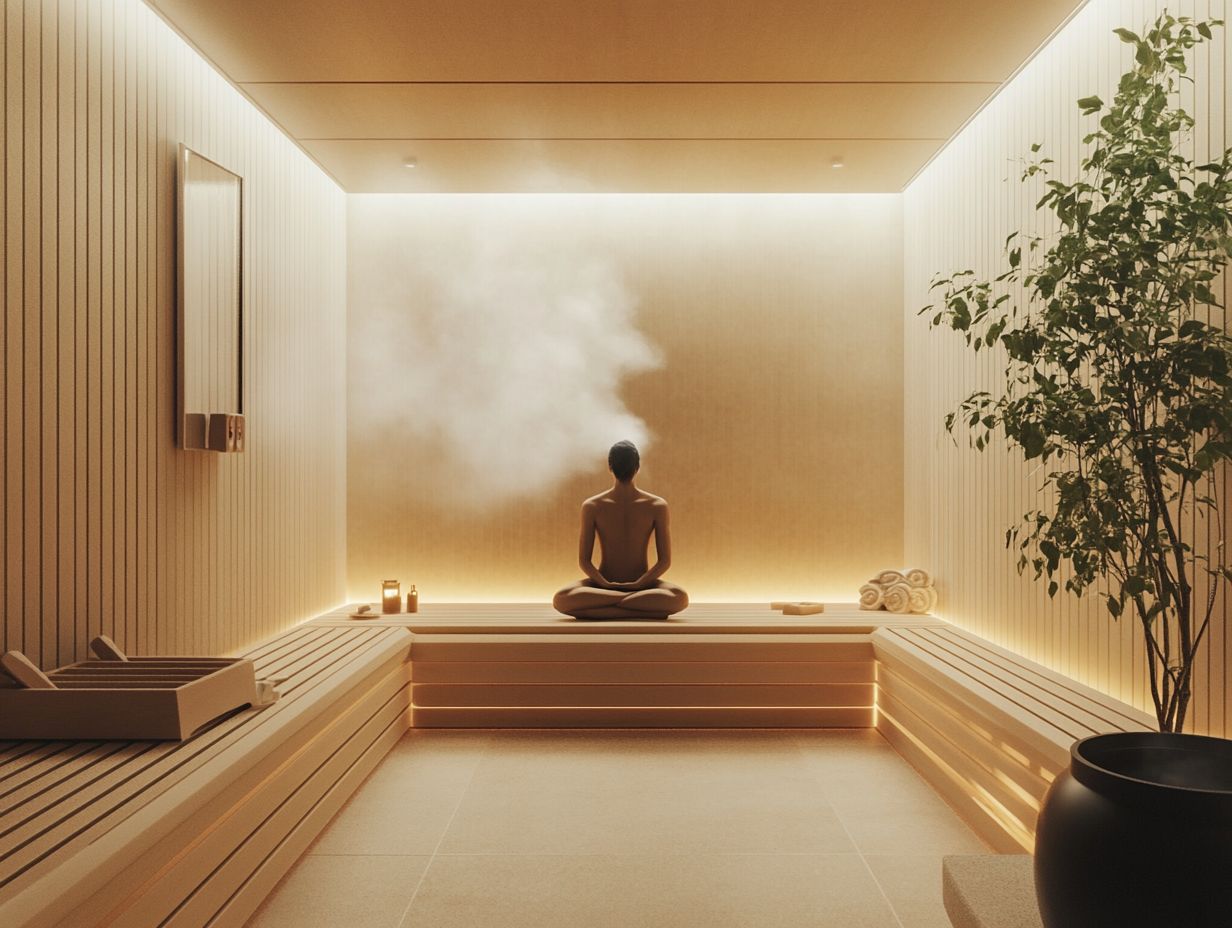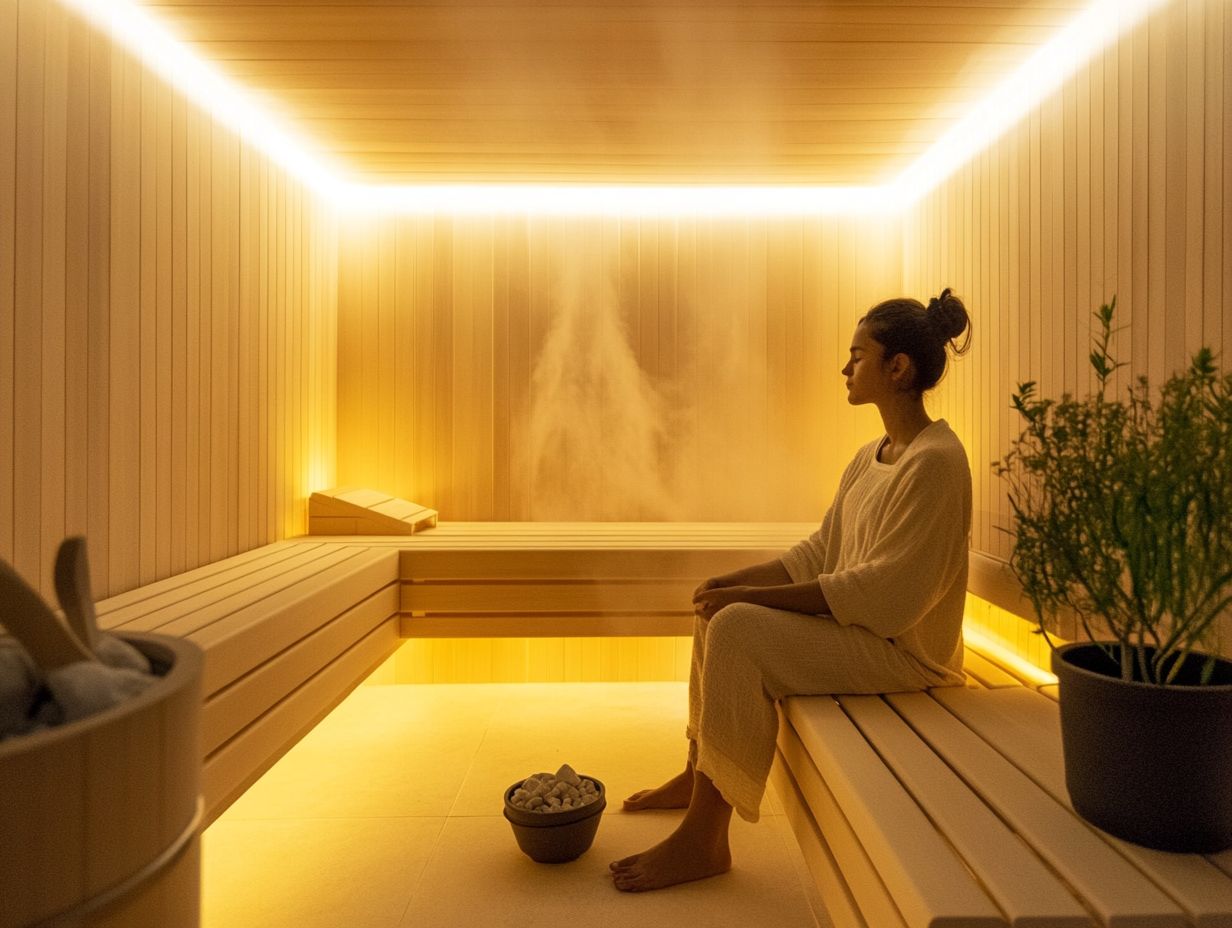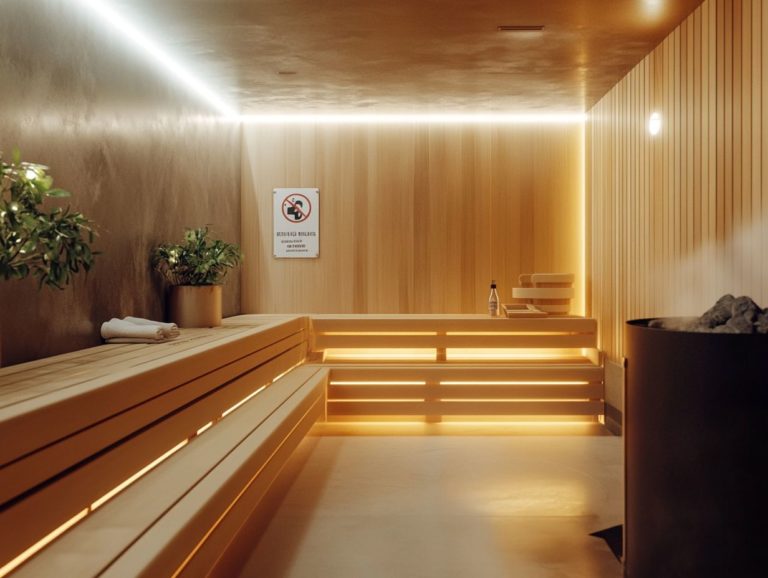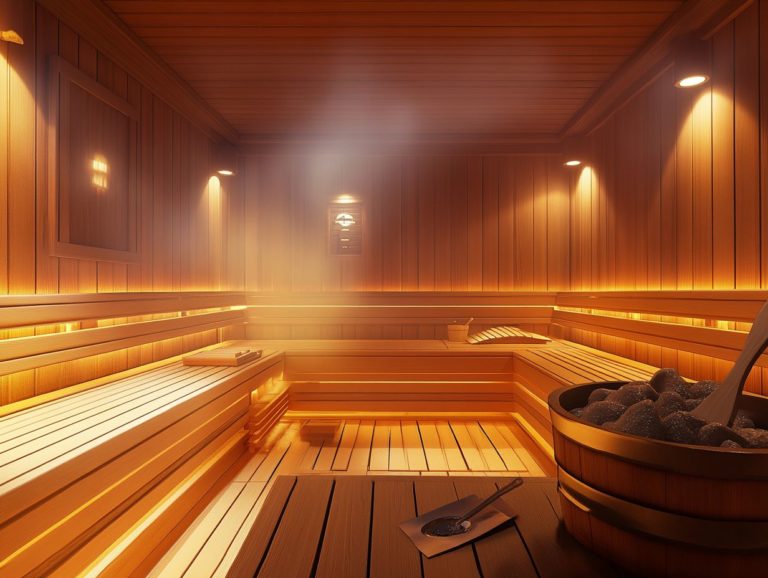Sauna Safety: Encouraging Self-Reflection
Saunas offer a unique mix of relaxation and health benefits, including improvements to mental health. Understanding how to use them safely is crucial for your well-being.
This exploration will cover what saunas are and how they work. We ll also discuss potential risks, such as heat-related injuries and other health concerns. You ll learn essential precautions to take before entering, ensuring you’re well-prepared for your experience.
Get tips to enhance your sauna sessions. We ll focus on minimizing risks related to hydration, cooling techniques, and the importance of listening to your body.
Get excited about the benefits your sauna sessions can offer!
Contents
- Key Takeaways:
- Understanding Sauna Safety
- Potential Risks of Sauna Use
- Precautions to Take Before Sauna Use
- Maximizing Benefits and Minimizing Risks
- Frequently Asked Questions
- What is sauna safety and why is it important?
- What are some common safety hazards in saunas?
- How can self-reflection be encouraged in sauna safety?
- Are there any specific rules for using a sauna safely?
- What are some signs that indicate the need for immediate exit from a sauna?
- Can children use a sauna safely?
Key Takeaways:

- Regular sauna use can provide numerous health benefits, but it’s important to understand and mitigate potential risks.
- Proper preparation, including hydration and listening to your body, can help minimize the risk of heat-related injuries in the sauna.
- Sauna sessions can also be a time for self-reflection and mindfulness. Prioritize relaxation and self-care while using the sauna.
Understanding Sauna Safety
Understanding sauna safety is essential for anyone eager to explore the numerous health benefits associated with sauna use, such as relaxation, removing toxins from your body, and improved cardiovascular health.
An infrared sauna is a modern type of sauna providing unique advantages, but it also has specific safety considerations due to its heat intensity.
As sauna culture gains popularity, especially within wellness trends and fitness goals, it s crucial to prioritize your health and well-being to fully enjoy your sauna experience.
What is a Sauna and How Does it Work?
A sauna is a cozy retreat designed to immerse you in a high-temperature environment. This sanctuary offers relaxation and various health benefits, from stress relief to improved cardiovascular health, whether you choose traditional or infrared methods.
Traditional saunas, often linked to Finnish culture, use hot stones or wood-burning stoves to create a steamy atmosphere. In contrast, infrared saunas warm your body directly with light, making the experience quite different. The enveloping heat of a traditional sauna creates a communal vibe similar to ancient Turkish baths or Slavic banyas, where social connections flourished.
Infrared saunas provide a more tolerable experience at lower temperatures, allowing longer sessions and a deep sweat without the intense heat of traditional saunas. Each method offers unique benefits, catering to diverse preferences and wellness goals.
Potential Risks of Sauna Use
While both infrared and traditional saunas offer various health benefits, it’s essential to recognize the potential risks involved.
Heat-related injuries and other health concerns may arise, especially for individuals with chronic pain or underlying health conditions. A safe sauna experience requires you to pay careful attention to these factors.
Heat-Related Injuries

Heat-related injuries can creep up on you during a sauna session if you’re not aware of your body s tolerance for high temperatures. It’s crucial to understand the specific risks associated with both infrared and traditional sauna experiences.
These risks include heat exhaustion, cramps, and, in severe cases, heat stroke. Recognizing signs such as excessive sweating, dizziness, confusion, or nausea is essential for a safe sauna experience.
To avoid these injuries, stay hydrated before and after your sauna visit, limit your sessions to about 15-20 minutes, and, most importantly, listen to your body.
Recognizing the mental health benefits of regular sauna use like stress relief and an improved mood can motivate you to practice sauna safety mindfully, allowing you to enjoy the therapeutic effects of heat while safeguarding your well-being.
Other Health Concerns
When considering sauna use, it s essential to look beyond just heat-related injuries. There are other health concerns to keep in mind, particularly those involving chronic pain and cardiovascular health.
If you have any medical conditions, it may be wise to consult a healthcare professional before diving into sauna activities. Conditions like hypertension or a history of heart disease can present risks in a sauna, where high temperatures and heat stress might amplify these issues.
If you have respiratory disorders, the humid environment of many saunas could pose challenges. Seeking expert advice before incorporating sauna sessions into your routine ensures that your experiences are both enjoyable and safe.
This ultimately enhances your overall well-being.
Precautions to Take Before Sauna Use
Before stepping into the sauna, it s essential to take specific precautions to ensure your safety and maximize health benefits. Be aware of any medical considerations and adequately prepare for your sauna sessions.
These steps will enhance your overall experience.
Medical Considerations
When contemplating a sauna session, particularly an infrared sauna, consider medical factors. This is especially important if you re dealing with chronic fatigue syndrome, fibromyalgia, or other health concerns that might be aggravated by elevated temperatures.
If you have cardiovascular conditions or heat sensitivity, it is wise to consult your healthcare provider before stepping into a sauna. While the sauna experience is often praised for its many health benefits, such as enhanced circulation and muscle relaxation, it’s exciting to discover your unique health needs!
You may find that making adjustments, like opting for shorter sessions or lower temperatures, can deliver therapeutic benefits. Acknowledge potential contraindications and embrace personalized recommendations to safely reap the wellness rewards of your sauna sessions.
Preparing for Sauna Sessions

Preparing for your sauna session involves a few key steps: hydration, choosing the right attire, and integrating relaxation techniques. These steps elevate the experience while aligning it with your health and fitness goals.
Hydrating properly before you step into the heat is crucial. Aim to drink plenty of water or electrolyte-rich beverages in the hours leading up to your session.
Choosing breathable, moisture-wicking clothing can significantly enhance your comfort. Consider dimming the lights or playing some soothing music to help your body truly unwind.
Embracing essential skincare practices, like moisturizing before and after your sauna time, ensures you feel good and contributes to your overall wellness.
Maximizing Benefits and Minimizing Risks
To fully harness the benefits of sauna use while minimizing risks, grasp proper hydration techniques. Heed your body s signals to appreciate the vital role sauna sessions can play in your workout recovery routine.
This thoughtful integration can significantly enhance your overall wellness. Embrace these tips and step into your sauna with confidence!
Proper Hydration and Cooling Techniques
Proper hydration and cooling techniques are vital for an enriching sauna experience. They help you maximize the benefits of getting rid of toxins and avoid overheating risks.
Without sufficient fluid intake before entering the heat, you might miss out on the session’s full potential to flush out toxins. This can lead to dehydration and diminish your overall wellness.
It s essential to hydrate with water or electrolyte-rich beverages beforehand to prepare your body for the intense sweating central to the cleansing process.
During your sauna session, remember that moderation is key. Listen to your body, take breaks as needed, and enhance your overall experience.
Afterward, cool down gradually to enjoy the full benefits of your sauna session. Start with a cool shower or relax in a cooler room. This approach helps stabilize your body temperature and enhances the detox effects achieved in the sauna.
Listening to Your Body
Listening to your body during a sauna session is essential for safety and enhancing your overall experience. It allows you to gauge how you re responding to high temperatures and truly maximize your stress relief benefits.
Being attuned to your physical sensations can make all the difference as you immerse yourself in this wellness trend. Pay attention to any signs of discomfort, like dizziness or excessive sweating, which might signal that it s time to step out for a moment.
Taking breaks prevents overstimulation and enriches your sauna experience, inviting a deeper level of relaxation. Practicing mindful breathing and relaxation techniques can elevate this connection, offering a holistic approach to wellness while you bask in the soothing warmth.
By embracing these signals, you cultivate a healthier relationship with your relaxation techniques, ultimately promoting your overall well-being and mental health.
Frequently Asked Questions

What is sauna safety and why is it important?
Sauna safety refers to the precautions and guidelines that should be followed when using a sauna. It is important because saunas can pose certain risks if not used properly, and following safety measures can help prevent accidents and injuries.
What are some common safety hazards in saunas?
Some common safety hazards in saunas include overheating, dehydration, slipping and falling, and exposure to excessive levels of heat and steam, which can affect your overall physical health.
How can self-reflection be encouraged in sauna safety?
Self-reflection can be encouraged in sauna safety by promoting mindfulness and awareness in the sauna environment, especially concerning fitness goals and workout recovery. This includes being conscious of your own physical limits, taking breaks when needed, and paying attention to any warning signs of discomfort or overheating.
Are there any specific rules for using a sauna safely?
Yes, there are some general rules that should be followed when using a sauna safely, such as enjoying traditional sauna practices and understanding their detox benefits. These include limiting sauna sessions to 15-20 minutes, staying hydrated, and avoiding alcohol and drugs before or during a sauna session.
What are some signs that indicate the need for immediate exit from a sauna?
Some signs that indicate the need for immediate exit from a sauna include dizziness, shortness of breath, nausea, or feeling faint. It is important to listen to your body and exit the sauna if you experience any discomfort or symptoms of overheating.
Can children use a sauna safely?
Children should use a sauna under close adult supervision and for a shorter duration, typically 5-10 minutes, as part of a seasonal wellness routine. Ensure that children understand the importance of following safety precautions and monitor them for any signs of discomfort or overheating.
Ready to enhance your sauna experience? Share your tips below!






